Shown below is the first color picture from Spirit. The one on the left is the official NASA version, and the one on the right is an adjusted, or re-adjusted, version of the same picture in which there is reduced redness. Which appears more natural or real to you? (Click on the pictures to see larger versions.)
Of course, it could be that the Martian landscape is really as red as the NASA version shows. But given that it's scientifically acceptable for the Martian sky to be more or less blue, combined with the fact that we have quite compelling photographic evidence like one shown below from the Viking missions exposing the excessive redness of the original pictures released by NASA (the adjusted version on the right shows the colors of the American flag accurately), it is not so farfetched to suppose that NASA has been deceiving all of us about the real appearance of Mars all these years. [The 'correct' image below was produced by Barry Arneson (?) in 2001.]
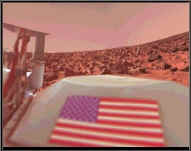

January 7-8: Canadian Press/Yahoo! News has posted an earth-like color version of the Mars picture from the NASA Spirit rover that is identical to the one used in my Jan. 7 post which was quickly produced with Photoshop.
Comparison ('official' version left; 'Canadian' version right):

[taken from here]

[taken from here]
By creating this kind of confusion, it becomes easier to gradually phase out the probably misleading, red Mars appearance familiar to us and bring in the more earth-like, 'real' pictures of Mars... But that's still just a theory.
January 9: Here is more (apparent) evidence of color 'manipulation' being done - deliberately or accidentally - by NASA. The illustration below I just produced should make the discrepancies rather plain. Very strange. (Pictures used in the illustration are from here and here.)
Update: The color change of the 'sundial' is not necessarily a sign of a 'conspiracy', but it does suggest, well actually it's a given, that the photo was not quite correctly calibrated. As Keith Laney states:
So far the only image showing the calibration target in the same view as the surface and sky showed conclusively that the image was not calibrated properly. The blue is hot pink, the green is virtually nonexistent and the red is brown. This explains the ruddy caste to the ground and sky in this otherwise beautiful image.
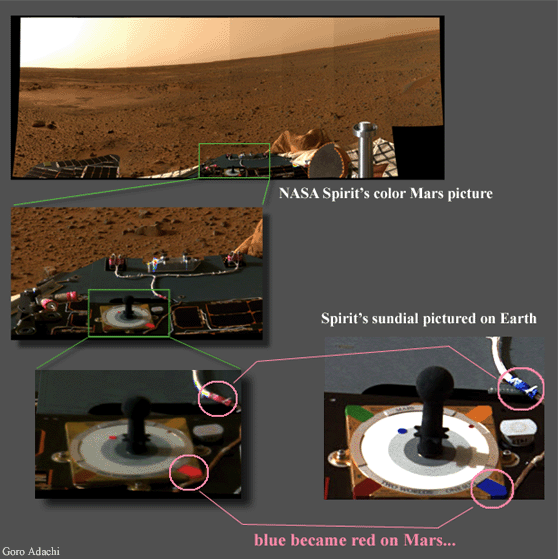
And here is another curious photographic anomaly brought to my attention...
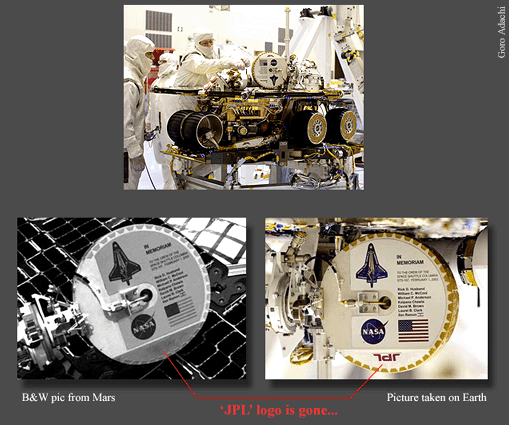
[Picture source]
What does this mean? Who knows... If you're puzzled, you're certainly not alone.
January 10-11: A light-blue sky of Mars shown during a NASA news conference (Jan. 10). I guess if the NASA guys don't make a big deal of the shifting colors of Mars, the media won't find it strange either. If this keeps up, Earth-like Mars images will become 'normal' rather quickly.
January 12: NASA released a 360-degree panoramic picture of the Martian surface. Well, it's still very red and the sundial area has been rather conveniently cut out from this photo.
January 13: On January 11, Keith Laney (a photo-processing expert) posted his carefully processed Spirit picture from Mars which he believes shows the true colors of Mars. In an online forum he gave us the following information:Making sense of the Pancam and colorlooking into this, we can see that actually the Pancam isn't true color, but it is close, a lot closer than Ody [Odyssey?]. Not that the representations we're seeing are correct.
"What!?!? not true color! exactly what do you mean mr. Laney?"
well, it is in sorts, but it isn't "true" because color response is actually varied depending on observer and other factors such as lighting and atmosphere. We all know that "true" RGB wavelengths are something that cannot be nailed down to a definite value, the response is more a curve. average response for RGB is a given however, and these values are..Red 650nm+/-
Green 510nm+/-
Blue 440nm+/-
Now we get to the Pancam, which is a remarkable piece of imaging technology, and very complex. It has two "eyes", left and right. they both see differently. Here are the filter positions.
LEFT CAMERA RIGHT CAMERA
L1. EMPTY R1. 430 (SP) *
L2. 750 (20) R2. 750 (20)
L3. 670 (20) R3. 800 (20)
L4. 600 (20) R4. 860 (25)
L5. 530 (20) R5. 900 (25)
L6. 480 (25) R6. 930 (30)
L7. 430 (SP)* R7. 980 (LP)*
L8. 440 Solar ND R8. 880 Solar ND
SP means short pass filter, LP means long pass filter. one lens on each side is coated so it can observe the sun (solar ND) L1 is clear, no filter
Using this chart for reference we see that the left eye is of main use for color imaging, with values covering acceptable rgb values. This means that in order for meaningful evaluation of the color or infrared combinations produced from these images to we will have to have them displayed so that we can obtain all the bands, and in more than compressed jpeg. which doesn't seem to be the case
until then, we have to "trust 'em". which is not imaging or science.[...] a vitally important point of [this is] that it is ENTIRELY possible for us to get unquestionably true color images out of this thing. I'm looking for more full left side imagery right now, and it will be very soon that I'm fixing to show you what Spirit says is the no crap about it true colors of this area. I just happen to have the answer for this shell game played with spectral bands.
And a little later Laney revealed his 'image showing 'Mars in true as you can get it color', adding 'It's an exciting day!'. Here it is. (Go to www.keithlaney.com/spirit_color_images.htm for more.)
This is very different from NASA's version, that's for sure... Very Earth-like. Is this the real Mars?
January 14: The New York Times has a little piece (titled 'Sure, It May Look Like Mars') discussing the growing 'conspiracy theory' concerning the poor-quality/manipulated images of Mars... Typical commentary from the mainstream press. (Thought not directly related, it may be instructive to read 'Paranoid Shift', an article about propaganda and 'conspiracy theories' these days...)
January 16: Keith Laney has posted additional information on how to 'correct' the NASA/Spirit pictures (see here). He comments:...the huge, hastily constructed pans with the ruddy color, stitch lines, and beige sky do not do justice to the actual beauty of the Martian surface. I offer an alternative view, one done with a fair degree of accuracy using common and measurable techniques. One which shows Mars may be more than we ever imagined. Two Worlds, One Sun.
January 19: Over at the ATSNN website there is a very detailed page explaining that the Spirit picture anomalies are actually not really a result of NASA manipulating the colors of Mars. It is probably too technical for most people (including me), but the explanation put forward there at least appears to make a good point. We are of course left wanting to see a counter-argument from the other side... and we do have this quick response from Keith Laney {slightly edited for smoother reading):I see some instant errors in that [explanation], though he does go at length to describe the process pretty well. A lot of the stuff he references I've also referenced to do the images. L4, 5, and L6 are definitely NOT RGB, but do make the tabs on the cal dial correct. If it is true what he's saying here then the red shift into the blue in "true" color would cause actual real color images to have a violet blue tab with the other color tabs basically correct.. which is what I've got on mine. We'll study this more. You could not get correct color with 2,5, and 6 either..
somewhat, but off.What is more important is centering the bandwidths with the images given, which he doesn't seem to cover.
I really don't see how he comes to an innocent conclusion for the reasons why the Pan releases are so red either, it's just not right.And so... that's where we are on this matter at this time. More updates coming as/if this development further.
January 21: With the title 'More Proof Mars Has Blue Skies', this picture from Viking 2 Lander (1979) was posted on Rense.com (validity unclear):
January 22: A striking picture shown below was just released by NASA. The caption states it "shows the rover's landing site, the Columbia Memorial Station, at Gusev Crater, Mars. This spectacular view may encapsulate Spirit's entire journey, from lander to its possible final destination toward the east hills."
This image is remarkable in that it finally shows, clearly and fully, both the Martian landscape/sky and the landing vehicle. This combination would represent less room for hiding potential color imprecision/anomalies/manipulation. And NASA/JPL appears to be well aware of this situation, as the caption put under the picture includes this note: "Data from the panoramic camera's green, blue and infrared filters were combined to create this approximate true color image." Hmm... An 'approximate true color image'. That's an interesting phrase.
More intriguing is this BBC news article about the same Spirit picture. As far as I'm aware, it is the first mainstream hard news article to directly address the puzzling color issue of Spirit/Mars. Here are some excerpts from the article:
- "Colours in the image have been adjusted but scientists have not yet determined the "true" colour of the Martian rocks."
- "Nasa scientists have used the colour calibration target, also known as the sundial, to adjust the image so that its hue is a close approximation of the colour of the Martian surface."
- "However, mission scientists will have to perform further calculations before they can produce an image that shows Mars' 'true' colour."
- "...the image shows signs of the correction process to get the colour of the Martian surface as close as possible to its true colour. The normally blue starscape - or "meatball" - that forms the Nasa logo has turned a muddy red. And blue insulating foam surrounding cables on the lander has turned bright pink."
Is it just me or is there an aura of 'non-denial denial' and/or 'non-admission admission' emerging with this development? They seem to want to leave the impression that the colors of the Mars pictures are more or less accurate. And yet they also now carefully point out that we don't yet have the 'true color of Mars'.
Personally, I'm still seriously considering my original model... i.e. that there is a gradual politically-motivated 'disclosure' (or trickery) taking place, designed at least in part to get the public more interested in space exploration, so that space exploitation and miniaturization can be implemented just as called for by the hidden neo-conservative/PNAC agenda driving the Bush administration. There could be various other issues involved as well, of course.
Update: Today it is being reported that a 'serious anomaly' has made the Spirit rover 'go quiet'. Or in other words, it may be gone for good. If that's the case, then the 'disclosure' model would no longer apply for now (don't forget Opportunity that is about to land on Mars). Let's see... Spirit lands flawlessly on Mars at the beginning of January; Pres. Bush triumphantly announces his plan to get man back on the Moon and then to Mars; Spirit finds a lot of anomalous rocks and people are closely monitoring the 'shifting colors' of Mars; polls show Americans do not welcome Bush's space initiative; Bush doesn't even mention space exploration in his State of the Union speech on Jan. 20; and then Spirit goes down... Let's wait and see where this story goes next.
January 23: We have another news article (Australia's Herald Sun) that touches on the Mars color issue. It concludes with the following sentences:NASA has also revealed it colour-balanced panoramic photographs sent from the lander to approximate what a person might see on the Martian surface.
This has raised questions about whether the landscape is really red.
It appears the issue is becoming more mainstream now. Could this be part of the reason why Spirit 'went silent'? Here is an excerpt from a message sent to a 'Cydonia' email discussion forum that gives us further evidence that there was increasing pressure on NASA to produce the real color of Mars:
From: ---
Date: Thu, 22 Jan 2004 08:58:21 -0000
Subject: [cydonia] Not So Timid Press QuestionsSeveral of yesterday's postings complained about the press being timid about their questions. Well, I saw part of the C-Span coverage of the briefing (Jan 21). Many of the reporters asked "tough" questions in regards to the "true color" issue, including Chandler (spelling?) from New Scientist. One reporter asked something like "Why is it called the red planet if [parts of] it is blue?" There were perhaps 2-6 minutes of give and take between several reporters and a JPL team member about the issue of "true color". Basically, JPL/NASA said that they were in a hurry to get "something" out to the folks, and that real true color processing will probably take about 2 weeks or so.
And now Spirit is suddenly silent... But it's not yet completely dead, and Opportunity is arriving there soon, so the game is not over yet.
January 29: Well, Spirit seems to be recovering at this time, and Opportunity has successfully landed on Mars, already giving us more pictures of the not-so Red Planet. Here is one, processed by Keith Laney, showing Mars in its likely true colors.
Today another mainstream news article appeared in the UK that directly addressed the Mars color issue. Slowly, but this subject appears to be gaining some momentum.
Nasa accused of painting Mars red
By Robert Uhlig, Technology Correspondent (Filed: 29/01/2004)The American space agency Nasa has been accused of doctoring its pictures of Mars to make the Martian surface conform to our impression of the famously red planet.
Nasa has been accused of digitally "tweaking" drab brown scenery to make it redder. It has even been suggested that Nasa removed green patches to hide evidence of life.
The theories gained credence after Nasa told New Scientist that "getting the colours right is a surprisingly difficult and subjective job", the magazine reports today.
Most of the pictures have been taken through green, blue and infra-red filters - instead of green, blue and standard red filters, which would have produced more accurate colours.
Dr Jim Bell, who worked with Nasa on the Mars rovers' cameras, said infrared filters were used because they helped geologists to distinguish rock types.
In reality, Mars appears red largely because of the dust in its atmosphere.
This article is a little strange in that it fails to mention the source of the accusation. Well, I guess they didn't want to say 'those crazy websites on the net could be right after all...' :) And the last sentence is curious in that while seemingly leaving the impression that Mars is red in reality, that's not quite what it's saying. It's actually stating that when there is a lot of dust in the Martian atmosphere, we'd see more red on the surface and in the sky. And the amount of atmospheric dust depends on the Martian weather. In other words, the sentence could easily be interpreted to mean 'Mars is normally not that red'.
February 1: Here is an interesting one from Hoagland/Enterprise Mission. Pretty much self-explanatory... Could be evidence of color manipulation? We'll see.
UPDATE: The 'NASA color' image above (left) was actually in grayscale/B&W originally. The color was manually added later by Don Davis who writes:
A prominent web site [i.e. Enterprise Mission] known for unconventional expressions has appropriated this image and used it with a caption suggesting it is a NASA image. It is not, it is my mosaic of several THEMIS and MGS images I fitted together in between my paying jobs.
Further info from elsewhere ('The Bad Astronomer'):
...I talked at length with artist Don Davis, who made it clear what is going on. [...] Don does not work for NASA. The original data come from NASA, but the color processing was not done by NASA. [...] He... colorized the image by hand, using the multicolor imagery as a guide. He has decades of experience in color and art, and feels that the color is as "reasonably close" to reality as he can get it. Even though it is colorized, he tried very hard to keep the tonal distribution correct.
As for the green color shown in the Mars Express image, the same states:
...we know from spectral analysis that the rock is basalt. We also know that basaltic rock is not green! Clearly, the images are not properly calibrated for color and tone balance. Don went as far to say "I would bet money that the dark areas are not green." Basically, when taking three images using different filters and combining them, you have to be very careful about color balance. [...] I have sent email to several scientists about the Mars Express image, and I hope to get a clear response about the color calibration.
So it appears that this particular claim [or at least inference] of Hoagland/TEM may not be valid. Still, the green color in the Mars Express image is really there in the original photo, and it would be very interesting to see if this too may a product of the annoyingly delicate calibration process. Already, however, we have this quote from Michael McKay, Flight Operations Director of European Space Agency, regarding the apparent greenness of Spirit's landing site:
...certainly like the green in the Gusev crater picture or by looking at the development of darker spots toward the South Pole which are tied to seasonal variations, it certainly gives rise to the speculation that there could be algae.
So from this we could perhaps infer that Mars Express is not suffering from the color 'instability' phenomenon plaguing the American counterparts. At least the director of ESA doesn't seem worried about the color being incorrect.
February 2: Asked by Linda Moulton Howe in an interview, Jean-Loup Bertaux, Ph.D. (Director of Research, Service d'Aeronomie du CNRS, Verrieres-le-Buisson, France) stated the following concerning the true color of the Martian sky:...I think it is a very important question. And in fact it is not a triviality. I think it should be asked to NASA: is this the true color (of the sky)? I think it is very important. The sky color might change with the quantity of dust particles in the air. Sometimes they may be red or less red, depending upon mainly the size of the dust particles. There might be a lot of very fine dust grains that might have a slightly different color from the big grains, I would say. So, the question is not trivial. It is important and it is interesting that the public is asking such a question.
As I said before, this issue is gaining momentum...
February 5: We find two more articles, both published on Jan. 28, dealing with the Mars color issue. Here is one from Ananova, titled 'NASA denies "sexing up" Mars images':US space scientists have defended themselves against allegations that they tampered with images of Mars. The claim is that Nasa experts "tweaked" pictures sent back by the two Mars rovers to make it redder. [...]
Nasa said this was due to the photos being taken through green, blue and infrared - rather than red - filters. When infrared images were printed as red, the results were fairly accurate but with some glaring exceptions. Blue and green, found on the spacecraft but nowhere on the Martian surface, looked especially odd. Blue came out as deep burgundy or pink, while green ended up as a kind of mustard. Nasa said it used infrared filters because they provided better information for geologists, helping to distinguish different rock types.
In reality the redness of the Martian surface depended greatly on its sky. [...] The quality of the Martian red light varied with the level of dust as well as the time of day.
And then we have webpages created by NASA/JPL, titled 'Revealing Mars' True Colors'. This doesn't reveal anything new either and its content can be condensed into the following:
“Getting the colors right is not an exact science,” says Bell. “Giving an approximate view of what we’d see if we were there involves an artistic, visionary element as well – after all, no one’s ever been there before.” However, great pains are taken to be as accurate as possible, short of going there ourselves. [...] So far, however, the images produced are only approximate martian colors.
February 11: Even the New York Times has now published an article about the color issue. Here are the concluding sentences from it:...there was no reason for the Spirit to see pink on Mars. When producing the panorama, the camera also used the red filter.
"We just made a mistake," said Dr. James F. Bell III, the lead scientist for the camera. "It's really just a mess-up."Ah ha! Turns out it was all just an honest 'mistake'. Yes, I'm sure... (Please.) This is getting pretty funny.
So we are now getting more and more clues and admissions suggesting that Mars really is not that red as NASA photos suggest. The fact that the mainstream press is covering this issue tells me that there is actually a subtle push from behind the scenes to disclose the real Mars to the general public. What separates my position from most others discussing this issue of Mars' color is that I view the Mars controversy as a carefully managed operation designed to gradually reveal what has been kept secret until now - to encourage us to go out into space... to Mars, because a certain 'timetable' demands this at this very point in history. (We won't going into that on this page.) And we should be careful with this as it's likely a 'gift' containing a deadly 'virus' like the Trojan Horse or Pandora's Box...
March 2: Well, no updates in the last few weeks because not much new is developing in terms of the Mars color issue. Indeed, how can there be a further development when NASA has just stopped releasing any meaningful color images of the Red Planet?! Sure there have been some here and there, but very limited. NASA/JPL spews out a lot of excuses to revert to stupid B&W photos... ostensibly for geologists who apparently don't care for colors. (Well, they should be reminded that they are using our money to do all their stuff at NASA and we, this being the 21st century and all, deserve to see some decent color pictures for a change. It's absurd. Multi-million dollar missions to Mars and they can't even take good color pictures? Come on now...)If I sound a little testy here, it's partly because I've found those astronomer/geologists involved to be quite arrogant. I listened to Linda Howe's interview with Steve Squyers, principal investigator on the Mars Rover Missions, during which, when the subject of organic life on Mars was brought up, he became agitated and downright rude to Howe - as if she asked a forbidden question. The reaction was appalling, certainly not something you'd expect from real scientists. (You can read the transcript of the interview here, near the bottom.) The thing is, they know what they want to discover - or what they think they will see on Mars - and their big egos (or brainwashed minds) won't leave room for anything else. It's quite comparable to how the Bush administration went after the Iraqi WMDs, really.
At any rate, we are still seeing the continuation of the apparent 'gradual disclosure' of the true, earth-like, colors/nature of Mars in the mainstream press. The latest is the recent news articles with titles like 'Rover captures dusty sunset in blue Martian sky' (CNN.com) that discuss an Opportunity picture taken on Feb. 26, showing the Martian sunset and a blue sky.
So whether the NASA people/culture (cult?) like it or not, I still see some hidden 'political' force pushing this and related issues, apparently in order to make Mars more inviting to us. While there are many agendas involved here, at the very basic level the Red Planet is getting ready to become the next New World... just as the American New World is now very much in its sunset...
Meanwhile, NASA is expected to announce their discovery of evidence of past water on Mars later today in a press conference. I guess that can be considered big news, but... didn't we already know this more or less? Not surprising at all in any case... especially after what we've seen so far.
Here are remarkable color pictures processed by Keith Lanely:

The next step would be something like the 'discovery' of present water on Mars. Things are moving quickly these days - especially this year - so we probably won't have to wait that long for the 'next revelation'.
Update
NASA announcement #1 (Mar 02): Water Once Filled Mars Opportunity Landing Site
NASA announcement #2 (Mar 23): Mars rover sits on ancient beach

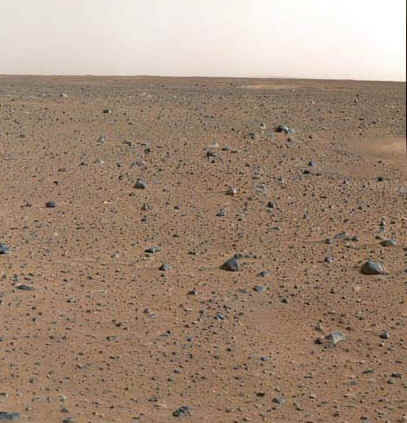






















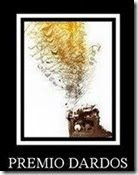


No hay comentarios:
Publicar un comentario